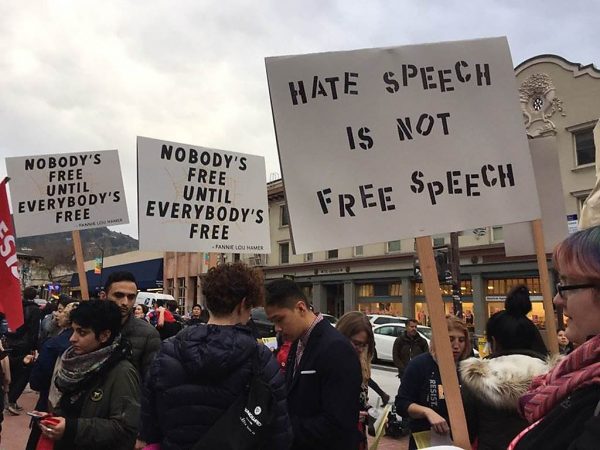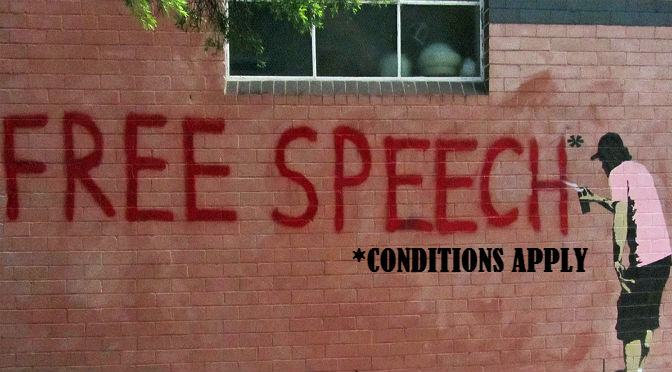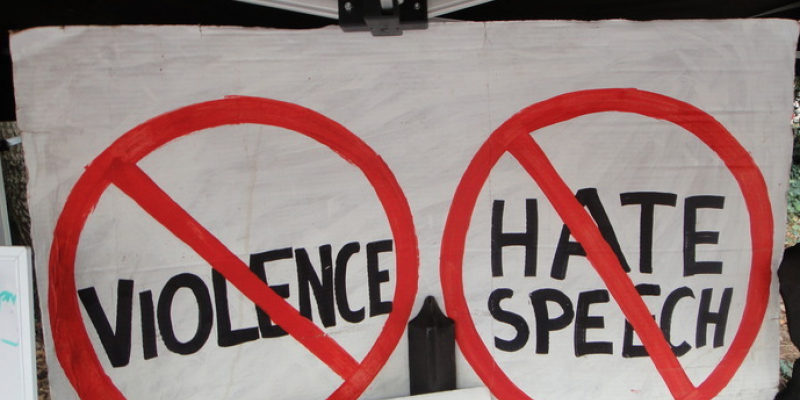Anti-discrimination regulations are their own kind of soulcraft.
Don’t Speak Your Mind if You Can’t Do the Time

The securitization of so-called hate speech.
On September 27, 2012, Nakoula Basseley Nakoula was arrested for making a movie which supposedly offended Muslims. That was not, naturally, the official charge. On paper, Nakoula was arrested for the parole violation of having used a computer and alias. Which he did, while making the video in question.
Yet no less esteemed a personage than Secretary of State Hillary Clinton made it perfectly clear that the real reason why Nakoula was dragged out of his home one night by sheriff deputies was that he had made a movie.
As the story went, Nakoula’s Youtube video was directly responsible for the sacking of the U.S. consulate in Benghazi, Libya—an attack which killed the U.S. ambassador, a member of the consulate staff, and two highly trained military contractors working for the CIA. As Charles Woods, the father of slain Navy Seal Tyrone Woods, told Fox News, “I gave Hillary a hug and shook her hand. And she said we are going to have the filmmaker arrested who was responsible for the death of my son.”
I could not help but think of the story of Nakoula as I read Arthur Milikh’s “’Hate Speech’ and the New Tyranny of the Mind” on the rising tide of the “Hate Speech” movement both globally and in the United States. Milikh’s report was an excellent contribution to documenting the increasingly worrisome threat to our liberties. When one considers Nakoula, the tyranny Milikh describes is less a speculative dystopian future than an increasingly actualized dystopian present.
Nakoula’s story demonstrates an element of the growing threat to free speech rights which is largely not covered by Milikh but which I would call the “securitization of hate speech.” That is, that the suppression of speech, and the categorization of certain types of speech as impermissible, is increasingly justified on the grounds of security.
Milikh accurately notes that American free speech rights were never understood to include incitement to immediate criminal violence. He also correctly identifies the long-accepted standard that in order to be illegal such incitement must be intentional, imminent, and specifically targeted.
But a subtle shift has been underway for some time now. This traditional understanding has transformed us from the common-sense position that it is reasonable to prohibit someone from deliberately inciting a mob to arson, loot, and murder, into an Orwellian drama where a California-based YouTube video can be held responsible for an orchestrated attack on a consulate half a world away by battle-hardened jihadists.
“Don’t Let’s Be Beastly to the Germans”
War has historically been accompanied by at least some of what might be called hate speech, usually with the acquiescence, if not the deliberate orchestration, of the government. This has been just as true of democracies—which must find a way to educate a public about the need to support violence against a foreign enemy—as of authoritarians. In the war to “make the world safe for democracy,” Americans were not much troubled by the government insisting on the need to “Beat the Hun.”
Yet in the nearly two-decades-long war described either with the moderately euphemistic phrase “The Global War on Terror,” or with the exceedingly euphemistic “Overseas Contingency Operations,” the impetus has been almost entirely in the opposite direction. Leaders seem to be taking their cues from the famed satire of Noel Coward: “don’t let’s be beastly to the Germans.” Or perhaps they were thinking of John Cleese in Fawlty Towers: “whatever you do, don’t. Mention. The war!!”
At least initially, the justification for downplaying the Islamic nature of the jihadists who attacked us on 9/11 was the need to avoid “backlash.” The notion—presumed by Western elites without usually being articulated in any official capacity—was that Americans and Europeans were such wellsprings of anti-Muslim hate that pogroms might break out after every terror attack. They never did, a reality which eventually became broadly mocked every time the “blowback” claim was trotted out.
The 2006 Danish Cartoon Controversy showed another way forward for the censorious. For many years, the Organization of Islamic Cooperation (OIC)—the massive U.N.-recognized NGO which purported to represent the entire Muslim world—had long been endeavoring to pass a U.N. Resolution criminalizing defamation of religion, by which they meant exclusively speech about Islam. The Western nations had engaged with them on this endeavor but had so far stuck to their guns on Western understandings of defamation and free speech.
When the Danish newspaper Jyllands-Posten published 12 cartoons of Mohammad, riotous “Days of Rage” followed. More than 200 people were killed, embassies sacked, churches burned. For OIC Secretary General Ekmeleddin Ihsanoglu there was no doubt where the fault lay. “I do not blame the people who demonstrate,” he said, “but rather I blame those who motivate these people, and as I said, we have extremists on this side and there are extremists on the other side.” The fault line for backing down Western notions of free speech would become—as the OIC accurately intuited—the inversion of the concept of incitement.
Recognizing that Western free speech had always permitted a narrow exception for “incitement,” the OIC proposed what came to be called the “test of consequences” standard. Rather than the traditional jurisprudence understanding of incitement, the OIC defined incitement by whether violence resulted, regardless of who instigated said violence. This meant that the speaker could be held responsible, even when violence was directly or indirectly intended to silence the speaker himself. In Ihsanoglu’s formulation, the speaker was the extremist who provided the “motivation” for the violence.
By 2011, The OIC would call for “constructively engaging to bridge divergent views on the limits to the right to freedom of opinion and expression.” The Obama administration would hurry to cross that bridge, with Secretary Clinton calling in the same year for the utilization of “old-fashioned techniques of peer pressure and shaming.”
Also in the same year, Secretary of Defense Robert Gates would call Terry Jones—pastor of a small Florida church—and urge him not to conduct a protest which was scheduled to include a public burning of the Quran. Top U.S. General David Petraeus publicly “condemned” the stunt and warned that the act would put U.S. troops at risk in Afghanistan.
However odious one might find the burning of books, it is undoubtedly legal speech under traditional American jurisprudence. Rather than pointing out that the U.S. military exists to defend the rights of its citizens to speak freely—even imprudently—Petraeus inverted the relationship between the citizenry and soldiery, such that our forces in Afghanistan were now regarded as little more than hostages to the good behavior of Americans, lest they do or say something our enemies (or for that matter supposed Afghan allies) might object to.
Jones eventually succumbed to the pressure and relented, which didn’t stop the city of Gainesville, where Jones resided, from billing the church $200,000 for the security costs associated with his demonstration.
And of course, the arrest of Nakoula in 2012 made clear that the Obama Administration had moved well beyond mere “peer pressure and shaming” to fully adopt the logic of the “test of consequences.”
With governmental acquiescence, this insidious logic spread to society at large.
Cry Fire and We’ll Burn Down Your Theater
On May 3, 2015, two jihadists who had sworn loyalty to the Islamic State traveled from Phoenix, Arizona to Garland, Texas, where they engaged in a shoot-out with Texas law enforcement outside the Curtis Culwell Center. Both were killed.
The attackers were seeking to enter the convention center, which was playing host to a “Draw Muhammad” Cartoon contest being organized by the American Freedom Defense Initiative (AFDI) led by Pamela Geller and Robert Spencer. AFDI was holding the contest—after paying nearly $10,000 for security—to protest repeated attacks and threats against free speech by jihadists and censors who feared jihadist wrath, from the Danish Cartoon controversy (2005), to the South Park Cartoon censorship debate (2010), to the horrific slaying of twelve people at the offices of the satirical French magazine Charlie Hebdo earlier that year.
Leaving aside the fact that the FBI was aware of the threat to the contest even before it occurred (an FBI undercover agent responded to messages from one of the attackers about the event by telling him to “Tear Up Texas”), the overarching elite response to the attack was that the would-be victims bore total responsibility.
The Washington Post summed it all up with its headline: “Event organizer offers no apology after thwarted attack in Texas.” The OIC could not have put it better.
The preferred narrative was that Geller’s and Spencer’s behavior invoked Oliver Wendell Holmes’s famed analogy of “crying fire in a crowded theater,” deliberately harkening back to a time before Brandenburg v. Ohio’s elaboration on the meaning of incitement and the very narrow permissible limitations on free speech.
Of course, even Holmess’ logic required that the fire crier be doing so falsely. Never mind that the entire exercise of the Draw Mohammad Cartoon Contest was intended to illustrate that free speech was under dire threat, which the attack and subsequent shaming proved beyond a doubt.
The implication of “crying fire” was that terrorism, like a stampede in a theater, is the inevitable consequence of “hateful” and “offensive” speech, rather than the deliberate choice made by terrorists to engage in violence in order to achieve a political outcome.
Of course, if you buy the farcical argument that the speech was the indisputable and ineluctable cause of the violence, then obviously it is the speaker who is the terrorist, as the author of a letter to the Sacramento Bee about the Garland incident declared: “The violence was predictable: It was her goal. In America we have a name for people who use violence as their political tool: terrorist.”
One Man’s YouTuber is Another Man’s Terrorist
At the same time as “incitement” was being redefined to mean something approximately the opposite of what it had previously legally meant, there was an effort to muddle how we understood terrorist violence. While the Bush Administration had expressed extreme reluctance to identify the jihadist threat in terms of ideology, the Obama Administration took this position to the extreme.
“Extremism” became the euphemistic term applied at first to the jihadist terror threat, and increasingly to any potentially fringe ideology. The government described its behavior as “countering extremism,” a nebulous term for which it has no mandate, rather than either as waging war or upholding the law, activities for which it is empowered.
This change in language had two simultaneous and paradoxical results. On the one hand it minimized the behavior of actual terrorism, portraying hardened members of foreign terrorist organizations as merely mixed-up youths with some weird ideas. At the same time, it equated holding any strong beliefs—on race, religion, even in support of enumerated constitutional rights—with potentially inciting terrorism. One could then be a free speech or Second Amendment extremist as easily as jihadist extremist. More easily, in fact, as the Garland incident showed.
In some cases this went too far, as when some U.S. Congressmen took umbrage at a DHS report that identified America’s many War on Terror veterans as potential “right-wing” extremist threats. But despite occasional pushback, the logic has marched on relatively uninterrupted.
It turns out that, contra Goldwater, extremism in the pursuit of liberty just might be a vice after all.
At the same time, the focus on “extremism” shifted the emphasis from real-world activities, like investigating and countering those who recruit, train, fund, and orchestrate actual terrorism in the actual world.
Supposed “extremism” experts huddled around their computers looking at social science and network models of “online extremism.” Their efforts conclusively showed that Ben Shapiro’s YouTube channel somehow inevitably leads youths on a pathway to white supremacy. The computer models were silent however on the role of Islamist organizations like the Muslim Brotherhood in promoting jihadist violence, to say nothing of mainstream media figures boosting the ideology of antifa with oft-repeated declarations that America is a country of white supremacy.
And yet after years of meetings between the U.S. government, extremism academics, and tech giants to discuss how to counter extremism online, somehow Hamas, the Taliban, and Antifa always remain active, while PragerU struggles to avoid being banned.
This equating of tweets and YouTube videos—in other words, speech, whether “offensive” or “hateful” or increasingly just contrary to established opinion—with actual real-world violence has saturated the discussion to a disturbing degree. It has actually become acceptable for sitting Republican senators to compare white supremacists chattering and posturing on Social Media with anarchist rioters looting and smashing America’s cities.
Policing of speech is dangerous to a free republic, for all the reasons that Milikh notes in “’Hate Speech’ and the New Tyranny of the Mind.” This is clearly evidenced by the fact that America’s narrow and sensible construction of criminal incitement endured as long as it did, even when partisans on either side may have temporarily benefited from altering it.
That consensus is gone now; it is not yet clear how it might be restored.
Increasingly, any one of us risks becoming the next extremist and facing the full force of an American government if we, like poor Nakoula Bassley Nakoula, say something to which someone powerful takes an objection.
The American Mind presents a range of perspectives. Views are writers’ own and do not necessarily represent those of The Claremont Institute.
The American Mind is a publication of the Claremont Institute, a non-profit 501(c)(3) organization, dedicated to restoring the principles of the American Founding to their rightful, preeminent authority in our national life. Interested in supporting our work? Gifts to the Claremont Institute are tax-deductible.
It’s time for a counter-revolution in moral rhetoric.
Conservatives and liberals alike let them do it.
A call to action.




